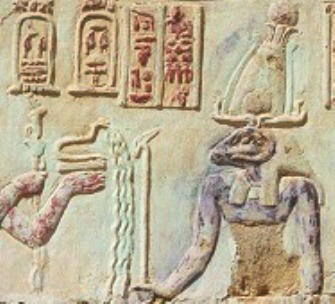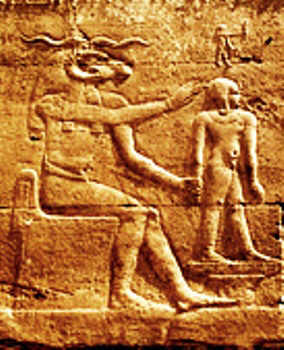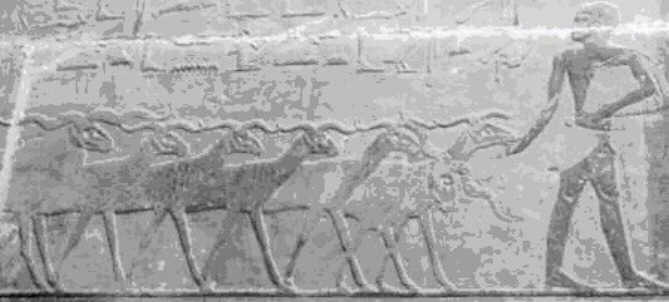Khnum in Egyptian Mythology
Khnum, the Egyptian god of fertility, water and procreation, featured in the stories, myths and legends in Egyptian Mythology. Khnum was one of the old cosmic gods described as "the maker of things which are, the creator of things which shall be, the source of created things, the father of fathers, and the mother of mothers." It was Khnum who, according to one legend, fashioned the children of man upon a potter's wheel made from clay and straw. The Consorts of Khnum
Khnum was worshipped in cities throughout Upper and Lower Egypt and their were many cults dedicated to this god. Ancient Egyptian Cities that achieved the status of a cult center became extremely rich and powerful and therefore there were several cult centers who featured Khnum with a number of different consorts who were goddesses favored in particular locations. He was associated with Heket a frog-headed fertility goddess but more often he was linked with Neith a war goddess, Menhit (a lion-headed war goddess) and Satet also another war goddess. Khnum the Protector
Khnum had roles of a protector of the Dead, the protector of the source of the Nile, and a protector of Ra on the solar barque and his protective roles were possibly the reasons why he was associated with so many war goddesses. 
Khnum Cult - The Elephantine Triad
Khnum was a member of the Elephantine Triad consisting of Khnum, Satet the war goddess of the Nile inundation and their daughter Anuket, the goddess of the cataracts. For additional information refer to the Triads of Egyptian Gods. Khnum Cult - The Triad of Latopolis
In another cult Khnum was the consort of Neith the goddess of war whose offspring was Heka the god of magic who together formed the the Triad of Latopolis. 
Khnum believed to be fashioning the divine child Heka on a potter's wheel Khnum, god of Fertility and Procreation
The fertility aspect of Khnum as the god of procreation (reproduction) is reflected in his role of moulding the infant and its ka within the womb, giving it the breath of life and then maintaining the health of the infant child after birth. Khnum in Egyptian Mythology - The Soul
Khnum was therefore credited with providing man with the part of the soul called the 'Ka'. The ancient Egyptians called the soul by two names - the Ka and the Ba. The Ka was believed to be the life-force of a person. Khnum is mentioned in a version of the Book of the Dead called the Papyrus of Ani. In this famous papyrus Khnum is mentioned in Ani's address to his heart. "Thou art my ka, the dweller in my body; the god Khnemu who knitteth and strengtheneth my limbs.
Mayest thou come forth into the place of happiness whither we go." The deceased, in mentioning Khnemu's name (also spelled Khnum), appears to be invoking his aid at the judgment in the Hall of Truths as he was the fashioner of man and the being who was responsible in some respects for the manner of his life upon earth. Symbols of Khnum - The Ram Headed God
The most striking symbol of Khnum is the ram. He is depicted in ancient Egyptian Art as a ram-headed god with green skin. Green colored skin was the color of vegetation and symbolized new life, rebirth and regeneration. Khnum is credited with giving man his soul (Ka) and in the language of the ancient Egyptians the words "soul" and "ram" sounded the same, which explains the significance of the ram as the symbol of Khnum. The peculiar, twisted horizontal horns, with spiralling horns coming out of the sides of the skull, as depicted on Khnum are like nothing we would now associate with a ram. The Latin name of the type of ram depicted is the 'Ovis longipes palaeo-aegyptiacus'. It is now extinct. But it was a type of barbary sheep that was found in the ancient Southern Egypt and Nubia. This species of ram, a domesticated sheep, was depicted on the relief's of the early tombs of Pharaohs. 
The Latopolis Triad at Esna
Esna was the cult center of the Triad of Latopolis consisting of Khnum, Neith and their son Heka where a great temple of was dedicated to the worship of these gods. Heka was the patron of magic and therefore also of medicine and Neith was a warrior goddess. Another lion-headed goddess called Menhit was also associated with the triad as the second wife of Khnum. The Elephantine Triad & Elephantine Island
Elephantine is situated at Aswan standing at the border between Egypt and Nubia and was the cult center for the three gods Khnum, Satet the war goddess of the flood or inundation and their daughter Anuket, the goddess of the cataracts. Elephantine was the capital of the state and for many years was the outer post of the Ancient Egyptian empire, a military post guarding the southern frontier of Egypt. A great great fortification was built on the island which served as defensive role for the border of Egypt but also as a place for commerce and trade with the Nubians, which might account for the name 'Elephantine' as there was a brisk trade in ivory at the island. The Egyptian Nile god, Hapi was also worshipped at Elephantine as he was believed to bring the silt to the banks of the Nile. Khnum was believed to guard and control the waters of the Nile from caves beneath Elephantine Island. Important Nilometers were located on the Elephantine Island to predict the volume and measure the inundation of the Nile. A Nilometer was associated with the Temple of Satis, with a stone staircase that descends down the corridor. There are records of an Egyptian temple dedicated to Khnum on the Elephantine island as early as the third Dynasty of Egypt in the period of the Old Kingdom (2686 BC - 2181 BC). The Khnum temple on the island was completely rebuilt in the Late Period (525 BC - 332 BC), during the thirtieth dynasty of Egypt, just before the foreign rule of the Romans. |